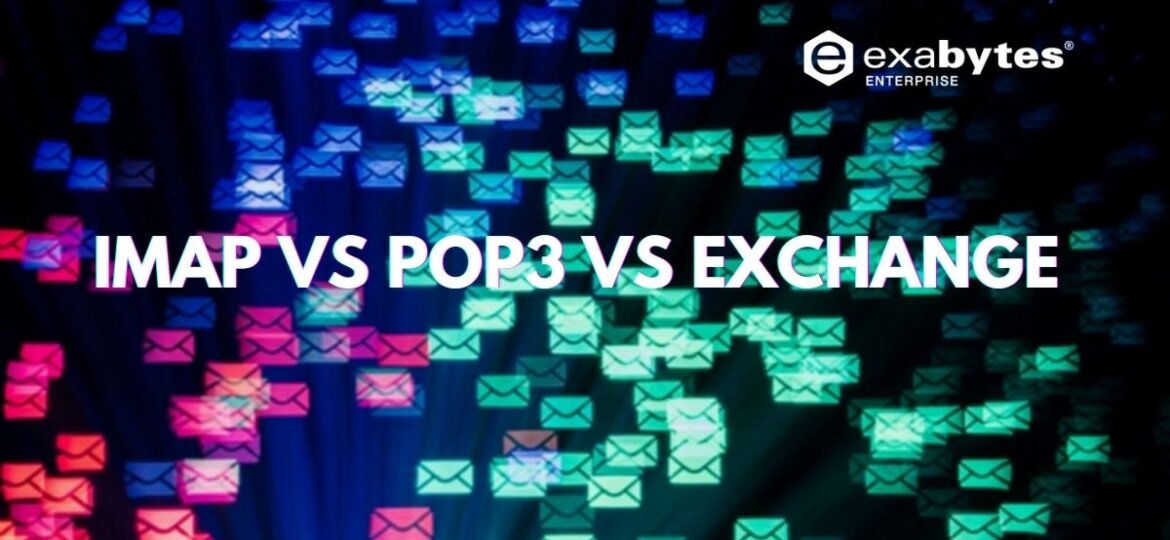
SMTP, IMAP vs POP3 vs Exchange: Email Protocols
Sending and receiving emails is possible, thanks to three main TCP protocols: SMTP, IMAP, and POP3. Whether you are using a custom email address or traditional managed email services like Gmail or Yahoo, the process of sending and receiving email is much more complex than many people realize.
In this article, we discuss the most commonly used email protocols in detail.
What is SMTP?
Simple Mail Transfer Protocol (SMTP) is the standard protocol used for sending emails. Allowing mail clients to send or forward messages to a receiving server. Similarly, a sender can instruct the SMTP server to transmit an email.
A primary consideration for network administrators and business cloud solutions providers when choosing between SMTP and IMAP is that SMTP mainly deals with sending emails. Therefore, if you want to send emails in your application, you should consider using SMTP rather than IMAP.
What is IMAP?
Internet Access Message Protocol (IMAP) deals with managing and receiving emails from the mail server. This simply means that this protocol is dedicated to retrieving messages and does not support sending emails.
IMAP is a very useful protocol for sending emails because it allows you to connect to your mail server from multiple devices. However, there are some common problems associated with this protocol. For instance, IMAP saves emails on a remote mail service, which limits mailbox size.
Therefore, if you expect to send many emails and wish to retain a copy of them, you may encounter issues using IMAP. However, this is generally a limitation of the mail server, and storage can often be upgraded.
As most business cloud services are highly scalable, you are unlikely to face these issues when using an enterprise cloud or business cloud solutions provider.
Combination of SMTP and IMAP
Whenever you send an email, there is a good chance that you are using both SMPT and IMAP; your email client, such as the Gmail app on your phone, will use SMTP to send the message to your mail server, which will then use SMTP to forward the email on to the recipient’s mail server.
Once the SMTP had delivered the email to the recipient’s mail server, the recipient’s email client will use IMAP to retrieve the message, which will appear in the inbox for the user to access. As you can see, both SMTP and IMAP are essential for sending and receiving emails.
What is POP3?
Post Office Protocol Version 3 (POP3) is another popular protocol used for retrieving emails. Many people tend to confuse POP3 and IMAP; however, some significant differences exist between the two that can make a big difference to email hosting and enterprise cloud-based email archiving solutions.
POP3 downloads the email from a server to a particular device, after which it completely removes the email from the server. Unlike IMAP, which saves the message on a server and only transfers a copy over multiple devices.
You can use either protocol depending on your requirements. Generally, IMAP is considered superior to POP3. IMAP is the recommended protocol for receiving emails on multiple devices.
However, suppose you only wish to receive emails on a single device, particularly if you have lots of emails you want to manage locally. In that case, POP3 could work for you.
What is Exchange (MAPI)?
Microsoft developed Messaging API (MAPI) soon after the introduction of IMAP and POP. However, MAPI is far more than just an email protocol, and there are many technical differences between these protocols.
In simple terms, MAPI allows email clients and various other applications to connect with Microsoft Exchange servers. It can synchronize emails, contacts, and other data very efficiently. Microsoft Outlook is based on MAPI, as its entire system is highly dependent on communicating with the Exchange.
Microsoft has advertised these features as “Exchange ActiveSync”. A major benefit of this technology is that Microsoft users of different devices like Windows, phones, or any other smart device can benefit from the power of Microsoft Exchange.
The Bottom Line
SMTP, IMAP, POP3, and Exchange are the most commonly used protocols for email hosting. Most leading business and enterprise cloud companies use these protocols to provide different email-related products and services.
There are many other protocols used for sending, receiving, and managing email; however, the protocols discussed in this article are by far the most popular and are sufficient to cover most business email use-cases.
